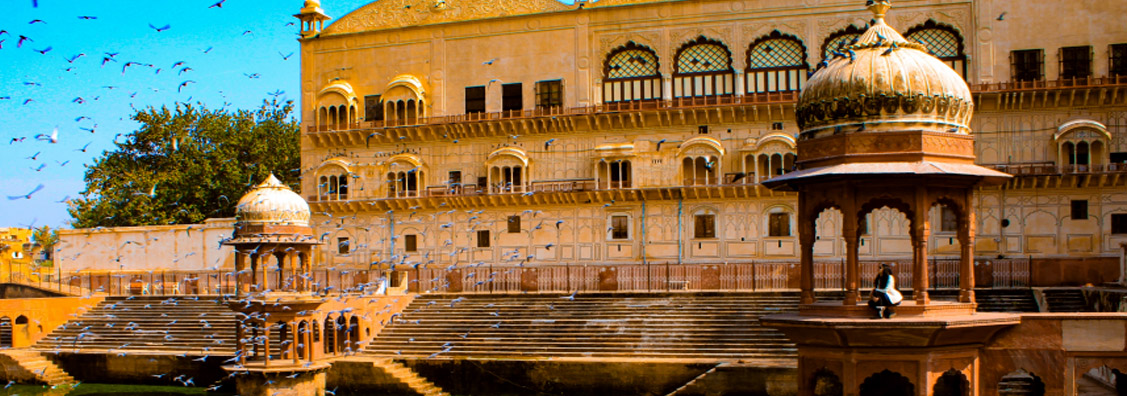

Home / Attractions / Alwar
Alwar is a gateway to the historic and colorful state of Rajasthan. Alwar has its own heritage which goes back to the mythological legends of the Mahabharata. Alwar is situated in the north eastern part of Rajasthan at an elevation of 237 meters above sea level. It lies 160 km south of Delhi and is about 150 km from Jaipur and covers an area of 44.76 square km. It is flanked by the barren hills of the Aravali range. Alwar has a chequered history and has been a witness to many rules and rulers. It offers various sites of historical importance to the traveller.
Alwar is also a nice tourist destination. The city is known for its rich history as it is an older city which dates back to the 1000 AD and that is why the rulers of the city also belonged to the 11th century. The city has many attractions including the haunted Bhangarh Fort and this is one of the major tourist attractions of alwar city.
Apart from that the city has many tourist attractions such as the Sariska Tiger Reserve Hanuman temple, Neelkantheshwar temple, and many more. The city is also a great place to enjoy shopping and enjoy the various other cuisines of Rajasthan. So apart from watching the ancient Alwar history through the palaces and forts the city is worth a visit for its flora and fauna too.
Alwar is indeed one of the historic destinations of Rajasthan which is decorated with fine examples of ancient times presenting the rich and royal history of the country. The city is considered as one of the oldest cities of India and which is known since 1000 A.D and was a part of the Matsya kingdom. At the beginning, the Kin of Amer ruled the city during the era of the 11th century and he extended his kingdom to include the city of Alwar. Later on the rulers of the city were ruled by different sub-clans of Rajputs such as Nikumbh Rajputs, Yaduvanshi Rajputs, Badgujar Rajputs and the city was under reign of the was Naruka or the Kachwaha Rajputs in the last phase.
The Alwar city is said to be founded by Maharaja Jai Singh of Amer and the city was named as Alpur, which changed with the time and lastly it was settled as Alwar. After that the city was first ruled by Maharaja Kakil during the 11th Century. The city of Alwar was also ruled by the Marathas and the Jats but a brave Kachwaha ruler named Pratap Singh took over the control of the city and ruled for many years making it a prominent place of Rajasthan. Pratap Singh was the 'Jagirdar' of a small village and later on he left the city to his, successor Bakhtawar Singh who volunteered an armed movement to the neighboring city ofJaipur, which is known as the senior Kachwaha state to keep the reign of his ancestor. While Bakhtawar Singh was defeated; a fresh commitment was made by the East India Company with him, keeping him out from any kind of political interference with other states without British consent.
Main Attraction and Sightseeing are being described below:
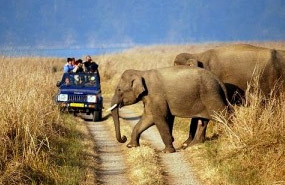
Sariska Tiger Reserve is well nestled in the Aravali Hills covering 800 sq km area divided into the grasslands, dry deciduous forests, sheer cliffs and rocky landscape. Whether you want to have camel safaris, go out for shopping in the surrounding places, visit medieval palaces or wildlife watching; Sariska Wildlife Sanctuary is the best place for you.
Nearly 90% of the area in the sanctuary is covered with dhok trees accommodating various wildlife species. A variety of other wild animals like the leopard, sambhar, chital, nilgai, four-horned antelope, wild boar, rhesus macaque, langur, hyena and jungle cats are found in the Sariska Tiger Reserve apart from the tiger. The Sariska National Park is home to India's largest population of peafowl, and harbours quail, sand grouse, golden- backed woodpeckers and crested serpent eagles, among other species. Also the Siliserh Lake on the edge of the park has a large number of crocodiles. The Sariska Wildlife Sanctuary houses the ruins of medieval temples of Garh-Rajor that date back to the 10th and 11th centuries. Also a 17th century castle on a hilltop at Kankwari provides a panoramic view of flying vultures and eagles. The Sariska was declared a sanctuary in 1955 and attained the status of a National Park in 1979.
Sariska park is home to numerous carnivores including Leopard, Wild Dog, Jungle Cat, Hyena, Jackal, and Tiger. These feed on an abundance of prey species such as Sambar, Chitel, Nilgai, Chausingha, Wild Boar and Langur. Sariska is also well known for its large population of Rhesus Monkeys, which are found in large numbers around Talvriksh.
The avian world is also well represented with a rich and varied birdlife. These include Peafowl, Grey Partridge, Bush Quail, Sand Grouse, Tree Pie, Golden backed Wood Pecker, Crested Serpent Eagle and the Great Indian Horned Owl.
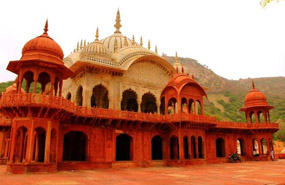
It is situated outside the main palace of Alwar, Moosi Maharani ki Chhatri was built by Vinay Singh in the memory of Alwar's ruler, Maharaja Bakhtawar Singh and his queen, Rani Moosi who committed 'sati' (self immolation on her husband's pyre). This beautiful cenotaph shelters the tomb of the king and the queen and the entire chhatri is supported by pillared sandstone.
The double-storeyed structure with Aravalli hills in the background looks stunning during sunset. The top floor is carved and designed entirely in marble. The interiors are adorned with some beautiful mythological paintings and frescoes on its ceiling. You may even spot some peacocks dancing around if the weather is pleasant. Perfect location and stunning architecture, lists Moosi Maharani ki Chhatri among the popular attractions of Alwar. However, the edifice calls for maintenance.
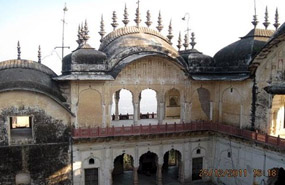
Bala Quila Fort is like a guardian to the city of Alwar, thanks to its location in the Aravalli Range, above the city. Bala Quila means the young fort but going by its sheer size, it is nothing less than a giant of a man made structure. It is around a kilometre away from the city centre and on a clear sunny day, one can see it standing atop like an alert guard protecting the city dwellers. It was built in the 15th century by Hasan Khan Mewati. This fort has been handed over from one dynasty to another like the Marathas, Yadavas and the Kachwaha Rajputs. It was the Kachwahas who laid the foundation of Alwar in 1775 after capturing the fort. Apart from its rich historical implication, it also provides an amazing view of the city of Alwar from an altitude of over 300 metres. This fort is so massive that it covers an area of 5 kms from north to south and 1.6 kms from east to West. The forts have six gates which are Jai Pol, Suraj Pol, Laxman Pol, Chand Pol, Krishen Pol and Andheri Gate. These gates stand testimony to the courage and gallantry of the Rajputs which is well known. The walls are wonderfully crafted which takes you back to the golden era of past. The fort also houses 15 large and 51 small towers!
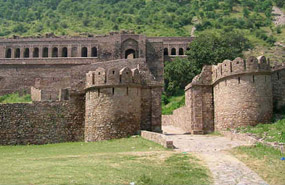
The Bhangarh Fort is located on the border of the Sariska Reserve in the Aravali range of hills in Alwar district of Rajasthan.[5]The nearest village is Gola ka Baas. The fort is situated at the foot of the hills on sloping terrain. The ruins of the King's palace are located on the lower slope of the hills; trees surround the pond area and a natural stream falls into the pond within the premises of the palace.
The fort is located 235 kilometres (146 mi) from Delhi and the approach to the entrance gate of the fort in the last 2 kilometres (1.2 mi) stretch of the road is an unpaved road.[5] The fort is 20 miles (32 km) from Thana Ghazi. The nearest airport is Jaipur International Airport which is 88.2 kilometers from the fort.
According to legend, a sadhu named Baba Balak Nath lived within the fort area, and it was his injunction that any houses built in the precincts of the fort should not be taller than his house, and if the shadow of any such house fell on his house, it would result in destruction of the fort town.[7] According to one popular folk tale, a wizard adept in black magic named N.K. Sinhai fell in love with Ratnavati, a beautiful Bhangarh princess with many suitors. One day, the wizard followed her to the marketplace and offered her a love potion, however she refused it, throwing it onto a large boulder that consequently rolled onto the wizard and crushed him to death. Before the wizard died, he supposedly made a curse that Bhangarh would be destroyed soon and no one would be able to live within its precincts. Subsequently, Bhangarh Fort was invaded by the Mughals from the north and the city was surrounded and sacked, and all inhabitants including the princess were killed. According to legend, the present state of the fort is the result of the wizard's curse, and the ghosts of the wizard and princess haunt the fort. Local folklore holds that the curse will be lifted someday when the princess is reborn and visits the fort.
Entering through the main gate of the completely ruined fort city, one can find temples, palaces, and havelis. In addition, there are four more points of entry to the fort – the Lahori Gate, the Ajmeri Gate, the Phulbari Gate, and the Delhi Gate.At the entrance of the main gate are many Hindu temples such as Hanuman Temple, Gopinath Temple, Someshwar Temple, Keshav Rai Temple, Mangla Devi Temple, Ganesh Temple, and Navin Temple.[5] The Gopinath Temple is built above a 14 ft raised plinth, and yellow stones are used for the exquisite carvings of the temple.[9] The residence of the priest, called the Purohitji Ki Haveli, is located in the precincts of the temple complex. Next in order is the Nachan Ki Haveli (dancer's palace) and Jauhari Bazar (market place), followed by the Gopinath Temple. The Royal Palace is located at the extreme end of the fort's limits.
The temples dedicated to Hanuman and Shiv Mahadev are built in the style of cenotaphs rather than temples. Jhiri marble has been used in their constructions, but presently they had been white washed. The Muslim tomb found outside the gate of the fort is reported to be that of one of the sons of King Hari Singh.
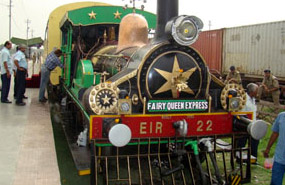
The Fairy Queen, is the oldest working Steam Locomotive in the world, built in 1855. It was completely over hauled in 1996 & resumed commercial operations in 1997 for 2 Days/1 Nights Tourist circuit from Delhi to Alwar with overnight stay in Sariska Tiger Reserve, as Fairy Queen train tour In 1998. It was Certified as the world's oldest working locomotive by the Guinness Book of World Records.
Recently, the Fairy Queen Engine has been replaced by another Steam Locomotive- WP 7161,built at Chittranjan Locomotive Workshop in 1965 & easily recognized by it's cone shaped bulging nose ,with a silver star devise painted on it.The train trip has now been renamed as Steam Express Tour & departs every 2nd & 4th Saturday morning from New Delhi to Alwar. You travel in comfort of Air-Conditioned Chair Car Saloon Car hauled by a steam engine & go back 50 years in time for once-in-a lifetime experience.
You are met on arrival at Alwar Railway Station in the afternoon & transferred to Sariska by Deluxe Buses for overnight stay in RTDC Tiger Den Forest Lodge/similar. Enroute brief halt at Siliserh Lake for high tea. Evening enjoy cultural program at Sariska.On Sunday early morning proceed for Jeep /Canter Excursion to Sariska Tiger Reserve, former hunting preserve of Alwar Royalty. The scrub thorn dry deciduous forest is home to Bengal Tiger, Leopard, Jungle Cats, Striped Hyena, Golden Jackal, herds of deer family, besides plenty of bird species & reptiles. Later you visit museum in Alwar town, before boarding the Steam Express by noon & arrive back in New Delhi on Sunday evening . Your travel,meals, overnight stay, sightseeing & jungle excursion are included in package cost.
The Steam Express has a 60-seater air-conditioned chair car specially designed with a large glass window from where you can have a frontal view of the Locomotive, besides there is a well maintained pantry car for on board catering. As an added attraction, the coach has a beautiful lounge in the front, which provides a scenic view of the countryside. In Sariska you stay in RTDC Tourist Bungalow/similar.
